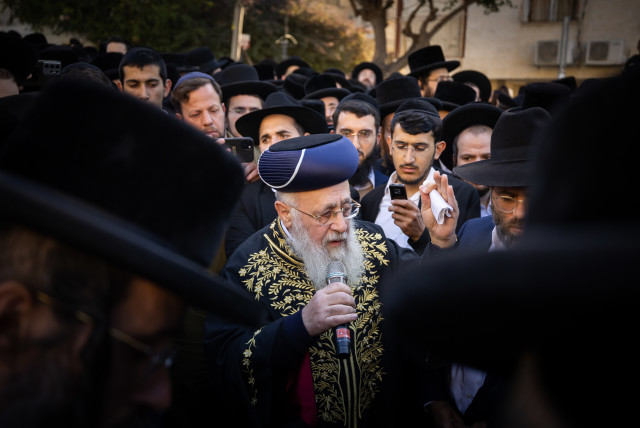Draft haredim to serve during their breaks from yeshiva - opinion

A national service plan for haredi men during their long semester breaks
Israel’s national security situation has taken an acute turn for the worse requiring at least another 7,000 combat soldiers a year for the next decade. But it cannot draft ultra-Orthodox (haredi) Israeli Jews against their will – no matter what the Supreme Court rules or the Knesset legislates.
Everybody knows that the rapidly growing and politically muscular ultra-Orthodox Jewish community in Israel can no longer altogether avoid military and/or national service. But haredi leaders will not relinquish their rigid communal structure of full-time and lifetime-long Torah study.
Every type of solution for this long-running deep ideological and societal crisis has been attempted over the past 30 years – and failed. This runs from massive government support for haredi integration in higher education and the workforce as a pathway to eventual military service, to choking off nearly all government support for haredi institutions. From persuasion to coercion. From backing to bludgeoning.
There was the Tal Committee outline and Shaked Committee strategy (both of which were legislated in law), the Plesner, Peri, and Stern plans– based on wise commissions that deliberated for years and promulgated visions of change in this matter.
These grand attempts at social engineering and compromise were cut short by impatient judges and politicians, or ignored from the outset by implacable haredi leaders. They failed because narrow and short-term interests trumped long-term thinking and any sense of overarching national unity.
Intra-religious dialogue between Religious Zionist rabbinical leadership (which encourages military and national service) and ultra-Orthodox rabbinic leadership (which discourages and even emphatically fights against this) has been attempted too – to no avail.
One group of rabbis learnedly quotes impeccable religious texts about the importance of combining national service with Torah study (or, in a similar fashion, gainful employment with Torah study), while the other group of rabbis refutes them with proof texts about the paramount value of Torah study alone and the desirability of standing aloof from secular society and the Zionist state.
Even now, as the most impressive, deeply Religious Zionist young men have been sacrificing themselves on military battlefields in numbers and proportions as never before, and their inspiring, agonizing, heroic stories pierce the hearts of haredi Jews in even the most closed ultra-Orthodox communities – haredi leadership is not budging.
‘We haredi Jews will abandon the State of Israel and move abroad if anybody dares attempt to draft us into the military’ – snarled the Sephardic chief rabbi Yitzhak Yosef this week.
(Yosef should be forced to watch the YouTube response to his outrageous remarks by Tel Aviv yeshiva dean Rabbi Tamir Granot, whose yeshiva student son, Amitai, was killed fighting in Gaza.)
But most Israelis don’t want haredi Jews to flee Israel, nor do I believe that most haredi Jews would do so, under any circumstances. Building a stronger and better Israel remains the shared national purpose.
And still, there are no good solutions on the table for the haredi draft exemption issue. Everybody knows that the situation is untenable, but nobody has a solution. We’re stuck in a situation where the draft of young haredi men to the military is essential and yet impossible, long overdue, and yet unlikely.
Haredim can serve in between terms of yeshiva
IT IS TIME for a new approach to break the logjam, what can be called the “vacation draft plan.” This will allow haredi men to continue learning Torah while serving military or national service during their semester breaks, which last 10 weeks a year.
Under my plan, no haredi youngster or married kollel man would have to miss a single day of scheduled yeshiva studies, any time, any year. They would serve only when they are anyway not “studying their hearts out” (or in the literal Hebrew phrase commonly used in the haredi world: “Studying to death in the tents of Torah”).
For the secular or Modern Orthodox Israeli this wouldn’t be a workable solution. In the normal course of things, professional people don’t get enough vacation from work to devote to another significant pursuit. In the working world, most employees (even senior executives) can take, at best, two or three weeks a year in personal vacation time, and this is insufficient for regular service in the army. It’s barely enough time for annual reserve duty. (The self-employed often cannot afford to take even a week off.)
But almost every yeshiva and kollel in this country operates on the same academic calendar with 10 weeks of annual vacation time.
Studies begin in the Hebrew month of Elul (August or September) with the first zman (yeshiva slang for semester) ending six weeks later before Yom Kippur. Then students and teachers are off on vacation through Succot until the beginning of Heshvan. Total vacation time, in one lump: three weeks.
The five-month winter study semester concludes at the end of Adar, whence yeshivas are closed for the entire month of Nissan (including Passover). Vacation time: Another four weeks. The three-month summer semester ends at the beginning of Av, launching another vacation break, amounting to an additional three weeks.
Total vacation accrued, for all junior and senior kollel men, yeshiva boys, and yeshiva educators of all ranks and stripes: 10 weeks of annual vacation. ultra-Orthodox society calls this bein hazmanim (between the semesters).
At these vacation times, you’ll find haredi youth and haredi families traveling the country, visiting its parks, shopping in its malls, and even occasionally traveling abroad – alongside holiday preparations. And yes, they study Torah during these breaks as well, in informal frameworks.
I say that well-endowed-with-vacation haredi men must forgo at least some of their time “outside the tents of Torah” to share in the national burden.
It could work like this: For, say, five out of their 10 weeks of vacation each year, ultra-Orthodox men would be drafted into especially refined, religiously protective frameworks – ranging from rescue services and rapid-response squads in their own communities to low- and hi-tech support units and even the infantry.
They would serve without missing a minute of any formal ‘seder’ or ‘zman,’ without missing a single class or exam, without disrupting their long-term Rabbinic or Talmudic study plans, and without emptying out the yeshivas (which is what the yeshiva deans fear most). And they can stay in the yeshivas and kollels for as long as they want – 20 or 30 or 40 years or a lifetime, if that is what they prefer (and can afford).
Some haredi men might have to miss out on the luxury of having a Pesach Seder at home or may have to spend Yom Kippur in the army or in a military hospital pushing wheelchairs, and their wives will alone bear the brunt of holiday preparations – but that’s a small price to pay for national responsibility and unity. A price that non-haredi Israelis have long born. You learn to grin and bear it, and even make this into teachable moments.
Call this giyus bein hazmanim – the vacation draft. Even after serving five or six weeks a year in the army (for multiple years), haredi men would still be left on average with an additional four to five weeks of annual vacation. Like I said, that’s much more than non-haredi Israelis get.
Note: My plan does not require haredi politicians or rabbis to abandon their high principles (– as haredi leaders like to insist: “No one who wants to study Torah should be prevented from doing so, without restrictions or quotas”). My solution won’t require the police to drag a single haredi youngster out of his yeshiva or his home.
Similarly, my solution for this vexing matter won’t require secular Israelis to put aside their nationalistic ethics or their values (as in, “One man, one vote, one soldier – no exceptions”). Nobody will have to stomach the unfairness of sending their son off to the military front while hearing the controversial claim that haredim are “equally putting their lives at stake in the tents of Torah.”
Indeed, my solution for the haredi draft issue embraces the opposing core principles of both the haredi and non-haredi camps, and yet manages to square the circle. It concurrently upholds the belief that the world of Torah study should be allowed to flourish without restriction in the State of Israel, and the belief that it is morally unacceptable that an entire class of Israeli citizens automatically be released from the burden (nay – the privilege) of defending the country.
I don’t belittle the spiritual importance, for national security too, that the haredi community attaches to constant study of Torah. But I’m saying that haredi men have the time and the ability to also serve in the military without egregiously cutting back on Torah study and without abandoning their unique way of life – if they care to fully share in the national security load and not just hide behind rusty ideological slogans.
For its part, mainstream Israel can facilitate increased haredi participation in the army (and by extension, in broader society) by adopting crafty and non-threatening compromise solutions, such as this proposal.
And in the meantime, until the vacation draft plan is implemented, wouldn’t it be nice if during bein hazmanim haredi men took their Talmuds and sat down to study with IDF soldiers on the Gaza or Lebanon border frontlines?
(Next week: A deeper dive into rival religious ideologies on this issue.)
The writer is senior managing fellow at the Misgav Institute for National Security & Zionist Strategy, in Jerusalem. The views expressed here are his own. His diplomatic, defense, political, and Jewish world columns over the past 27 years are at davidmweinberg.com.
Jerusalem Post Store
`; document.getElementById("linkPremium").innerHTML = cont; var divWithLink = document.getElementById("premium-link"); if (divWithLink !== null && divWithLink !== 'undefined') { divWithLink.style.border = "solid 1px #cb0f3e"; divWithLink.style.textAlign = "center"; divWithLink.style.marginBottom = "15px"; divWithLink.style.marginTop = "15px"; divWithLink.style.width = "100%"; divWithLink.style.backgroundColor = "#122952"; divWithLink.style.color = "#ffffff"; divWithLink.style.lineHeight = "1.5"; } } (function (v, i) { });

